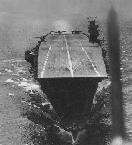mdiehl
Posts: 5998
Joined: 10/21/2000
Status: offline

|
Here is an excerpt from the air force veteran's association. I've read the details before (there are a couple of recent personal biographies and unit histories for B17s in the PTO). The link is: [url]www.afa.org/magazine/valor/1290valor.html[/url]
The quote, which gives at least a couple of anecdotal examples of B17s being effective as skip-bombers (I'll presume that faster tactical bombers were preferred when available) is as follows:
By John L. Frisbee, Contributing Editor
Skip-Bombing Pioneer
In the fall of 1942, a better way of sinking Japanese ships had to be found. Ken McCullar was one of the first to master the new tactic.
A priority task for the few Fifth Air Force B-17s of the 19th and 43d Bombardment Groups during the summer of 1942 was interdicting the Japanese sea line of communications from Rabaul, New Britain, to enemy forces on New Guinea. AAF doctrine then held to bombing from altitude with nine-plane (when that many were available) squadron formations. Results had not been good, especially against maneuvering ships. Only about 1 percent of bombs dropped were hitting their targets. Clearly a better way had to be found.
Promising experiments with skip bombing were under way in the US, based on RAF experience. Lt. Gen. George Kenney, commander of Fifth Air Force, was enthusiastic about the new technique. The 63d Squadron of his 43d Bombardment Group set to work in September, testing skip bombing with B-17s against a wrecked ship in Port Moresby Harbor. Approaching the target at 200 mph, aircraft released bombs at 200 feet or lower, about 300 yards from the hulk. The bombs would skip across the water into the side of the ship--if airspeed, altitude, and range were properly coordinated. Modified Australian fuzes were used in the absence of suitable US stock.
Capt. Kenneth McCullar already was credited with sinking or damaging four Japanese vessels, using conventional tactics. He soon became one of the most proficient practitioners of skip bombing, with 60 percent hits in practice runs. Skip bombing looked like the answer, but it added another element of danger to the normal hazards of combat. Chief among these was the nerve-racking experience of flying at point-blank range directly into the muzzles of deck guns on enemy ships. Since the older B-17s didn't have enough forward firepower to keep those guns down, early skip-bombing attacks were made at night, by the light of the moon or flares.
The Japanese were introduced to skip bombing at Rabaul Harbor on the night of Oct. 23, 1942. While six B-17s of the 64th Squadron bombed from 10,000 feet, six 63d Squadron bombers came in at 100 feet to skip their bombs into the sides of Japanese ships. McCullar reported sinking a destroyer with two hits amidships. Two nights later the 63d returned to Rabaul with eight B-17s, about a third of the Fifth Air Force's operational heavy bombers at the time. McCullar was one of four to score hits.
McCullar flew many more skipbombing missions; one of the most notable was on the night of Nov. 24, when he and other B-17 crews attacked an enemy convoy by flare light. His first run at 200 feet scored a near miss on a destroyer. On his second run, McCullar set the destroyer afire.
Coming back once more, his No. 1 engine was knocked out by flak, and the propeller couldn't be feathered. Too badly shot up for another low attempt, McCullar made a conventional bomb run at 1,200 feet and again was hit. He then climbed to 4,000 feet for a fifth attack and lost No. 3 engine to enemy fire. With only two engines running and three wounded men aboard, he was faced with a return to Port Moresby over 13,000-foot peaks. No. 3 finally was brought in at greatly reduced power. "Two and a half hours later," McCullar reported, "we were at 10,000 feet, our ceiling, and luckily we found a pass to sneak through, landed OK, and forgot about it."
Twice more McCullar brought his B-17 home on two engines, once from nearly 600 miles from Rabaul where he was on a photo-reconnaissance mission. Seventy miles short of Rabaul, a supercharger blew up, killing both engines on the left wing. McCullar completed the mission on two engines and flew back to Port Moresby with excellent photos of the Rabaul area. Two days later, on Dec. 7, he helped turn back a Japanese convoy, returning with more than 100 machine-gun and 20-mm holes in his B-17.
McCullar, by this time a major, led a charmed life, it would seem. His skill as a pilot and his determination to complete every mission regardless of the odds had earned him a Distinguished Service Cross. Then, as with so many other combat heroes, the odds caught up with him. On April 12, 1943, while taking off for an attack on a convoy, his B-17 crashed in flames.
"His exploits were already legends that would be told and retold long after the war," Kenney said. McCullar was a symbol of valor i n the dark days of the Pacific war. His courage and resolution
|
 Printable Version
Printable Version







 New Messages
New Messages No New Messages
No New Messages Hot Topic w/ New Messages
Hot Topic w/ New Messages Hot Topic w/o New Messages
Hot Topic w/o New Messages Locked w/ New Messages
Locked w/ New Messages Locked w/o New Messages
Locked w/o New Messages Post New Thread
Post New Thread